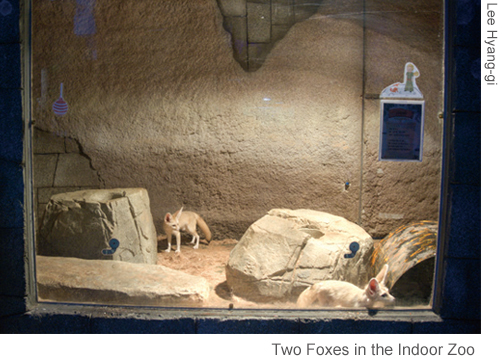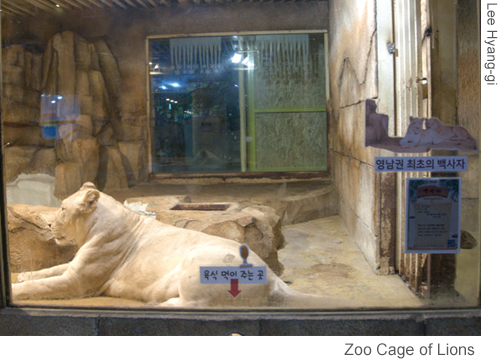In April 2023, a post of visitor revealing the poor conditions in a zoo in Daegu, Korea, sparked controversy on social media. The weary state of the animals filled many people with concern about the environment at the zoo.
This indoor zoo, located in the basement of a shopping mall in Daegu, covers 4,300 square meters, and houses more than 60 species. Various animals such as meerkats, geese, servals, hyenas, and white lions are on display in extremely harsh surroundings. Nocturnal animals are exposed to bright light even during the day, and constantly afflicted by the noise caused by humans. Birds such as parrots are kept confined in small and low-ceilinged exhibits, and reptiles such as snakes suffer in similar conditions.
Ten or even more rabbits and guinea pigs are crammed into tiny cages with limited range of motion, and ducks are made to stand on artificial structures without sufficient supply of water. Such harsh living environments prevent the animals from indulging in their natural instincts such as flying, digging, and running. Moreover, as the zoo is underground, animals cannot bask in the sun or breathe fresh air, which is essential for wild creatures.
The zoo also runs a feeding activity where visitors can feed animals with long metal skewers through tiny holes. The monkeys and desert foxes in the zoo demonstrate an over-reliance on the carrots offered by guests, whereas the lions display the opposite behavior. The latter particularly seemed to have no interest in the chicken provided by visitors, and they continue to lie down lethargically, staring into the distance.


The violation of animal rights has been a chronic problem in Korea. An indoor zoo in Daejeon also faced similar backlash for cramming its animals in narrow cages. On April 25, 2023, a series of photos of tigers, white lions, and bears in extremely narrow cages went viral under the headline “Shocking Daejeon Indoor Zoo.”
Wild animals were on display in a glasshouse, and there was no outdoor area for the animals to roam about. They were forced to sit on cold cement floors without grass, completely exposed to visitors. The stress induced by this environment caused some animals to exhibit stereotypical repetitive behavior such as moving around the cage meaninglessly or banging their heads against the wall.
There are various other “animal prisons” in Korea and they continuously make controversy every year due to the poor living conditions of most of these places.
What is Going on in the Indoor Zoos in Korea?


According to the First Zoo Management Master Plan (2021–2025) laid down by the Ministry of Environment in December 2020, 46 of the 90 private zoos in Korea operate as indoor petting zoos, where visitors can touch and feed animals whenever they want. The enactment and implementation of the Zoo and Aquarium Act in 2017 did away with the mandatory requirement to secure outdoor places, thereby allowing zoos to operate solely in the form of indoor facilities. This step has resulted in a significantly increased number of indoor zoos.
In Korea, zoo operations are currently regulated through a registration system based on which anyone can open and operate a zoo, provided they meet certain requirements. Those who want to run a zoo or an aquarium need to register only the facility’s location, the status of its professional staff, the number of animals, and the number of endangered species.
The registration also includes a plan on disease management, a suitable habitat environment, and safety management. However, there is no system to check the actual implementation of the plan or the state of management after registration. The regulations on safety management and the habitat environment are only declaratory and do not specify obligations to prevent possible accidents, diseases, or infections.
Regarding the habitat environment, except for 90 species of animals including some of the internationally endangered species, there are no specific regulations determining the standards of living environment of the animals. Additionally, punishment for violations does not exist, which means that there are no provisions for enforceability. These weak policies have allowed the creation and maintenance of zoos that are inhumane for animals; hence, a lot of zoos in Korea are called “animal prison.”
In addition, indoor zoos are promoted as places of enjoyment regardless of the weather. In the case of a zoo located in a complex cultural space, a great number of visitors is attracted by emphasizing the convenience of facilities. Contrary to the actual purpose of zoos, which is to protect animals, there are numerous zoos touting these advantages without consideration or care for the animals. This attitude has fostered an environment for unethical practices at zoos at the cost of the animals.
Owing to the lack of effective policy and a focus on human convenience, indoor zoos result in the following problems. First, indoor petting zoos do not fulfil even basic animal welfare standards. Artificial indoor spaces with artificial decorations and bright lighting are not suitable for wild animals. In addition, as hundreds of animals are huddled in a limited space, the minimum area requirements are often not satisfied for them to perform their natural activities freely. For example, in 2020, a lioness died at an indoor zoo in Pyeongtaek, Gyeonggi-do. She was confined to a single space without any distinction between the inner room and the outdoor area and with tiled floor. The animal rights organization Kara argued that the lioness could not even dream of lying calmly on the ground and lived a sad existence that was as good as death. Thus, animals are constantly suffering in such harsh environments.
Moreover, the prevalence of misguided exhibits and hands-on activities that use animals for means of entertainment make the situation worse. Direct physical contact with visitors is distressing for the animals that are already psychologically withdrawn in small cages and constantly exposed to humans. Close-range exhibits without boundaries expose them to unwanted visual, auditory, and olfactory stimuli. These hands-on activities also carry the risk of spreading infectious diseases. According to veterinarians who visited the indoor zoo in Daegu in 2019, without proper quarantine regulations, physical contact with animals can result in the spread of zoonotic diseases.
The debate over these problematic indoor petting zoos has seen a divergence of views from animal rights organizations, zoos, and visitors. Animal Freedom Solidarity condemns indoor zoos as ridiculous and anachronistic places where animals cannot feel the sun or breeze because of the lack of space and artificial structures. They argue that indoor zoos are not an appropriate place for animals to live, and that animals have the right to live freely and pursue their own habits and instincts. In addition, activists from animal rights organizations such as Animal Rescue 19, Kara, Hi, and Aware fervently call for an end to animal exhibitions that are hotbeds of animal abuse and disease transmission.
In response, the owners of indoor zoos argue that animal rights groups overgeneralize some of the issues to simply vilify zoos and emphasized that there is nothing legally wrong with operating indoor zoos. They also claim that they pay significant attention to the welfare of their animals by ensuring that they receive regular vaccinations and care in cooperation with veterinary clinics.
A 2018 survey by the Ministry of Environment revealed that 75.6 percent of respondents are critical of the conditions of indoor zoos and believe that “the welfare of exhibited animals needs to be improved.” Nevertheless, in reality, many people visit indoor zoos for pleasure without any regard for the state of its animals.
How Should Indoor Zoos in Korea Change?
The fact that zoos in Korea have come under fire several times in recent times shows that at least a section of people are concerned about animal rights. Unfortunately, many zoos in Korea cater to the selfish pleasure of humans instead of protecting endangered species and ensuring animal welfare.

To resolve this crisis, the Ministry of Environment is planning to change the zoo registration system in December, 2023, to a licensing system with proper zoo laws that is in place in most countries, including the US, the UK, and Australia. This system allows the operation of zoos only with facilities that take into account the ecological habit and habitats of animals and comply with animal welfare.
Periodic inspections by professional inspectors are required to monitor habitat environments, and inappropriate experiential activities should be restricted. It is necessary to make institutional efforts to ensure that zoos fulfill their primary function of protecting animals and providing accurate information about them. The new system will install a public surveillance system to monitor the upkeep of zoos. Moreover, the public attitude toward zoos requires a transformation.
Human beings must respect and understand the value of animals. Such changes in policy and public perception will create an environment where the animals can have a good living.
Lee Hyang-gi
lhg0523@uos.ac.kr

